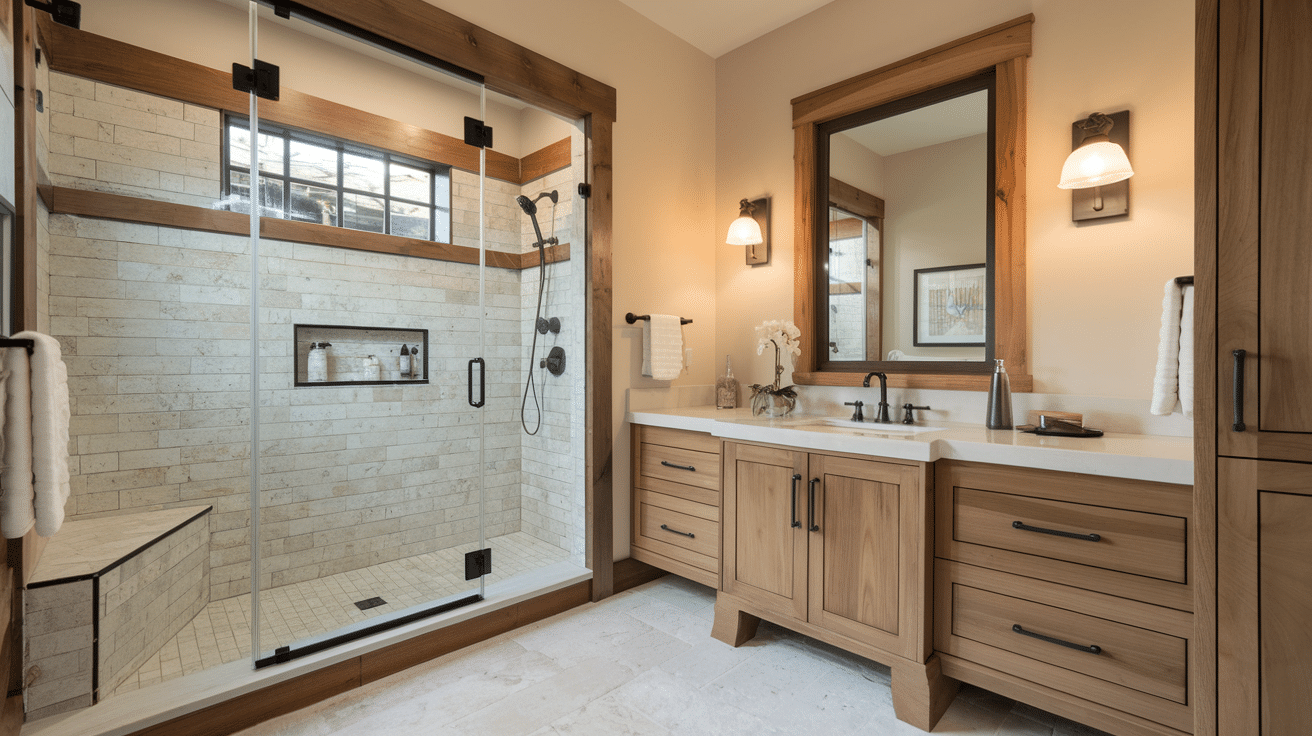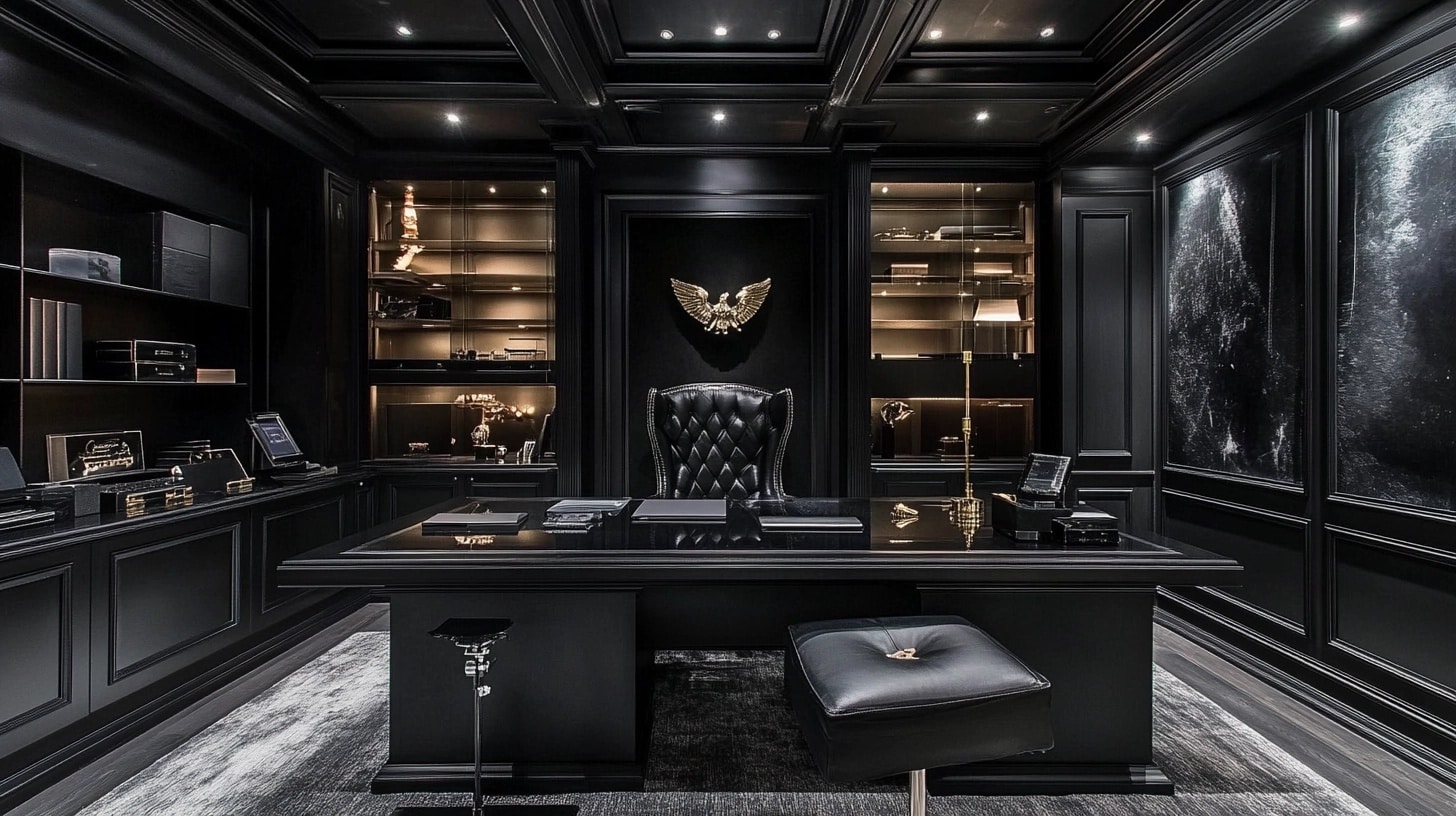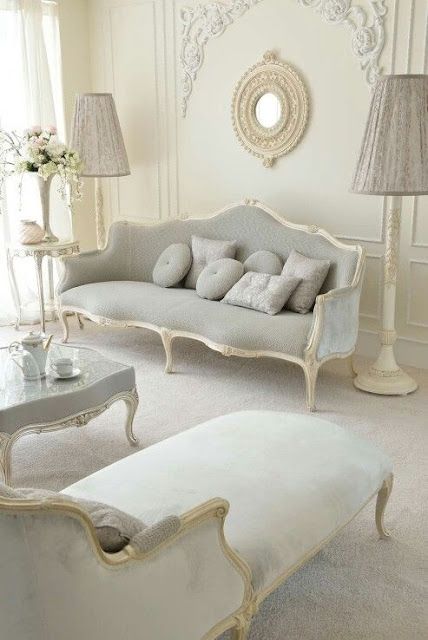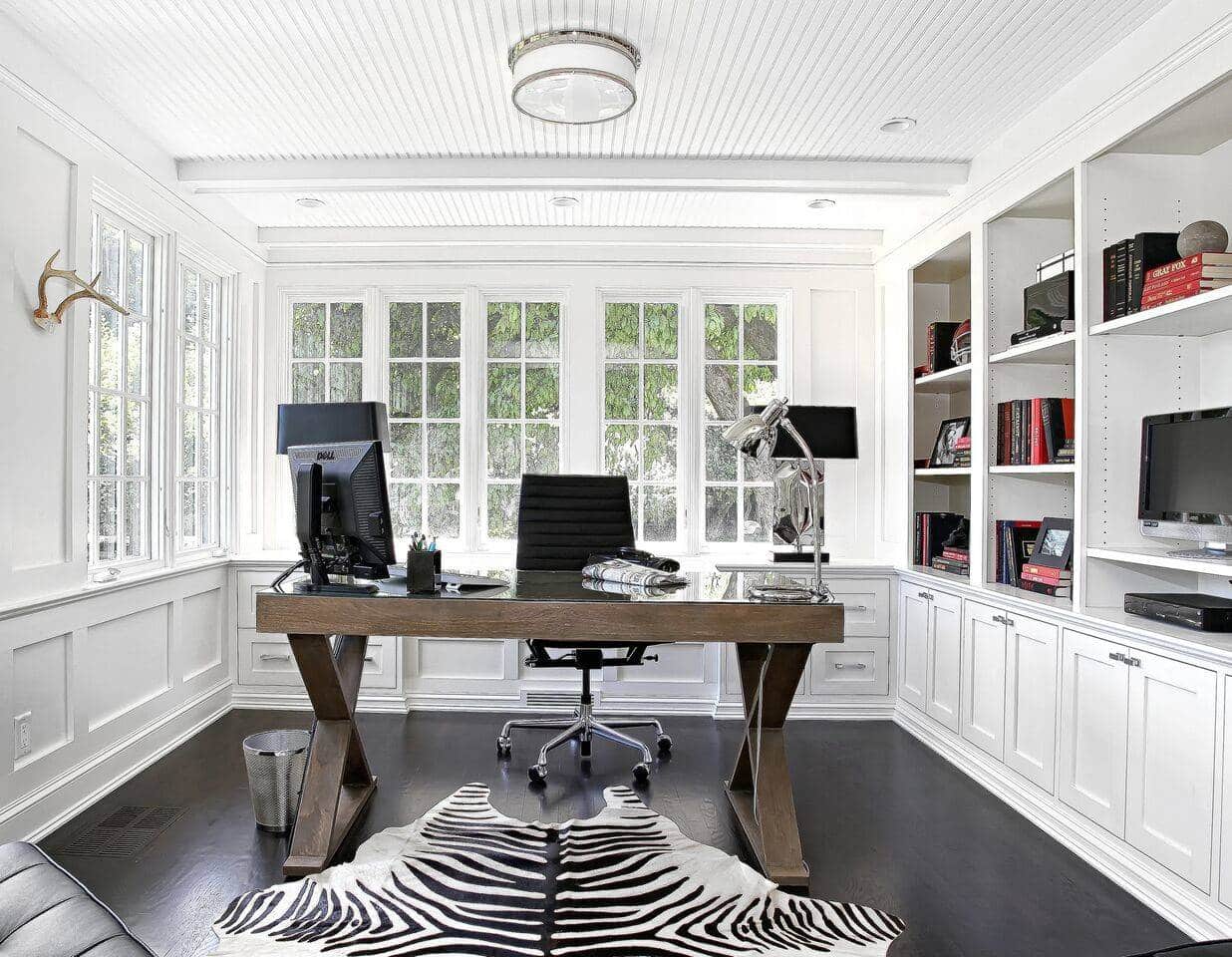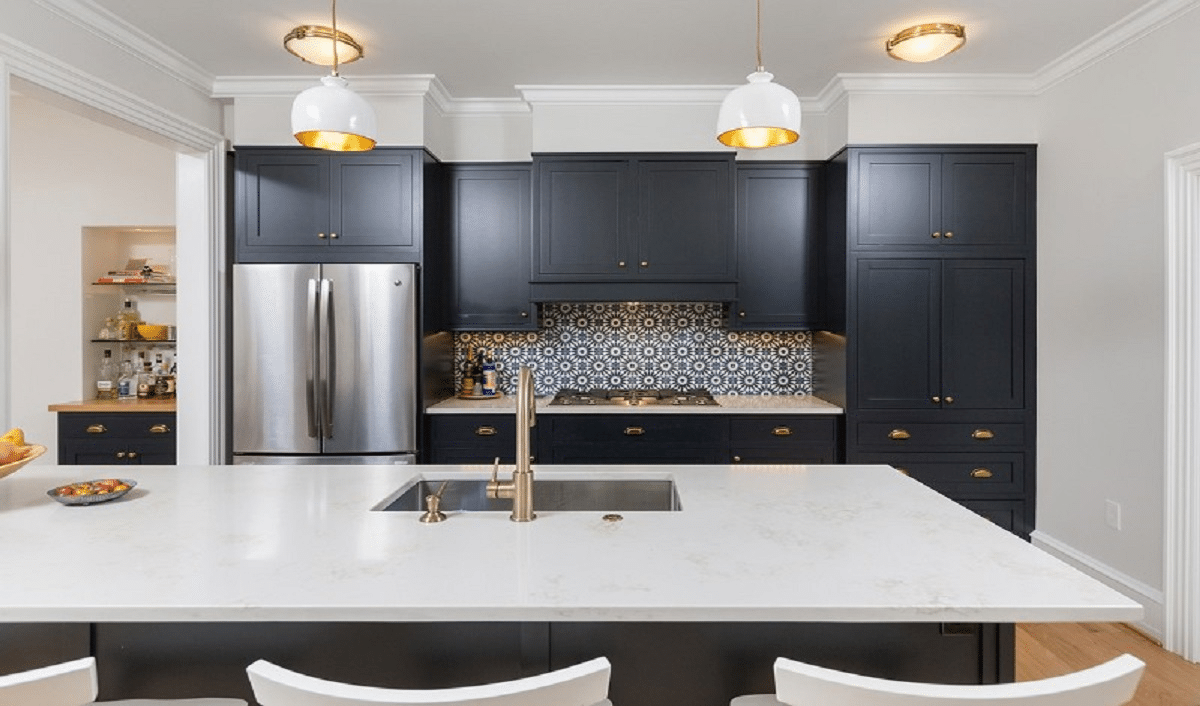Craftsman Bathroom Features for a Stylish Remodel
Want a bathroom that’s more than just practical? A Craftsman bathroom might be exactly what you need.
With its focus on handmade details, natural materials, and classic design, this style turns your bathroom into a peaceful, beautiful space.
If you’re tired of trends that quickly go out of style, a Craftsman-inspired bathroom will last for years.
In this guide, we’ll show you how to use warm wood, handmade tiles, and smart layouts to create a bathroom that feels both stylish and cozy.
No matter if you’re starting from scratch or updating your current bathroom, we’ll help you bring this style into your home.
Ready to create a bathroom full of character and charm? Let’s get started!
What Is a Craftsman Bathroom?
The Craftsman bathroom emerged from the Arts and Crafts movement, championed by design pioneers like William Morris and Gustav Stickley.
Born as a rebellion against mass-produced Victorian designs, this style celebrates handcrafted quality and functional beauty. It focuses on natural materials, artisan techniques, and a design philosophy that values simplicity and authentic craftsmanship.
Characterized by solid wood cabinetry, stone countertops, and handcrafted ceramic tiles, Craftsman bathrooms blend form and function.
The design features clean geometric lines, built-in storage solutions, and a color palette inspired by nature. Copper and bronze fixtures, warm earth tones, and a commitment to visible craftsmanship define these spaces.
More than a mere appearance, the Craftsman bathroom represents a holistic approach to design. It prioritizes quality materials, purposeful construction, and a connection to natural elements.
Each component, from pedestal sinks to carefully chosen tiles, tells a story of skilled workmanship and intentional design.
Key Features of a Craftsman Bathroom
The Craftsman bathroom embodies a design philosophy that turns an ordinary space into an artistic statement.
Rooted in the Arts and Crafts movement, this style celebrates authenticity through carefully selected natural materials, refined craftsmanship, and a deep respect for functional beauty.
1. Woodwork That Makes a Statement
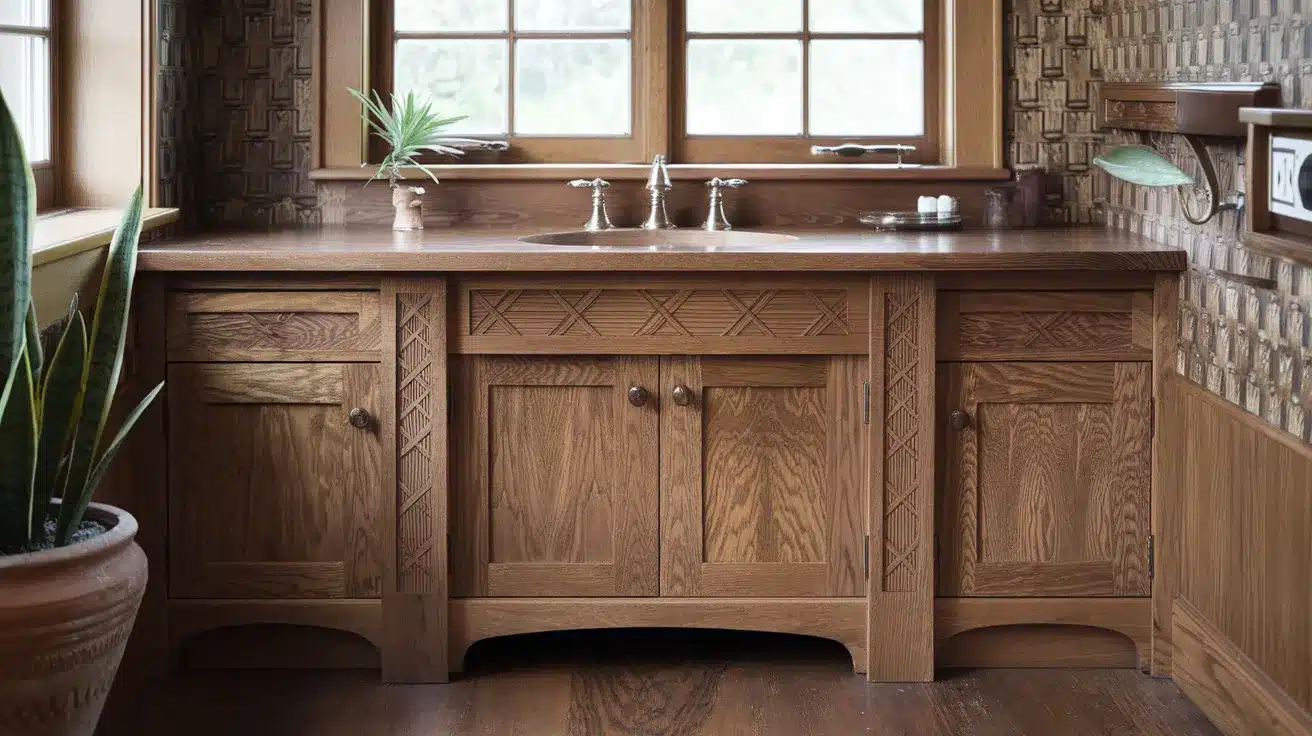
Wooden elements are the cornerstone of Craftsman bathroom design, filling the space with rich, natural materials that speak to true craftsmanship.
Quarter-sawn oak, cherry, and maple take center stage, creating cabinetry that goes beyond mere storage to become a design statement.
Intricate trim work, carefully crafted moldings, and built-in vanities showcase the wood’s natural grain and the skilled artisan’s touch.
These wooden elements are not just functional but serve as a visual narrative of quality construction, with each piece carefully selected and expertly finished to highlight the wood’s inherent beauty and character.
2. Tile Work with a Handcrafted Feel
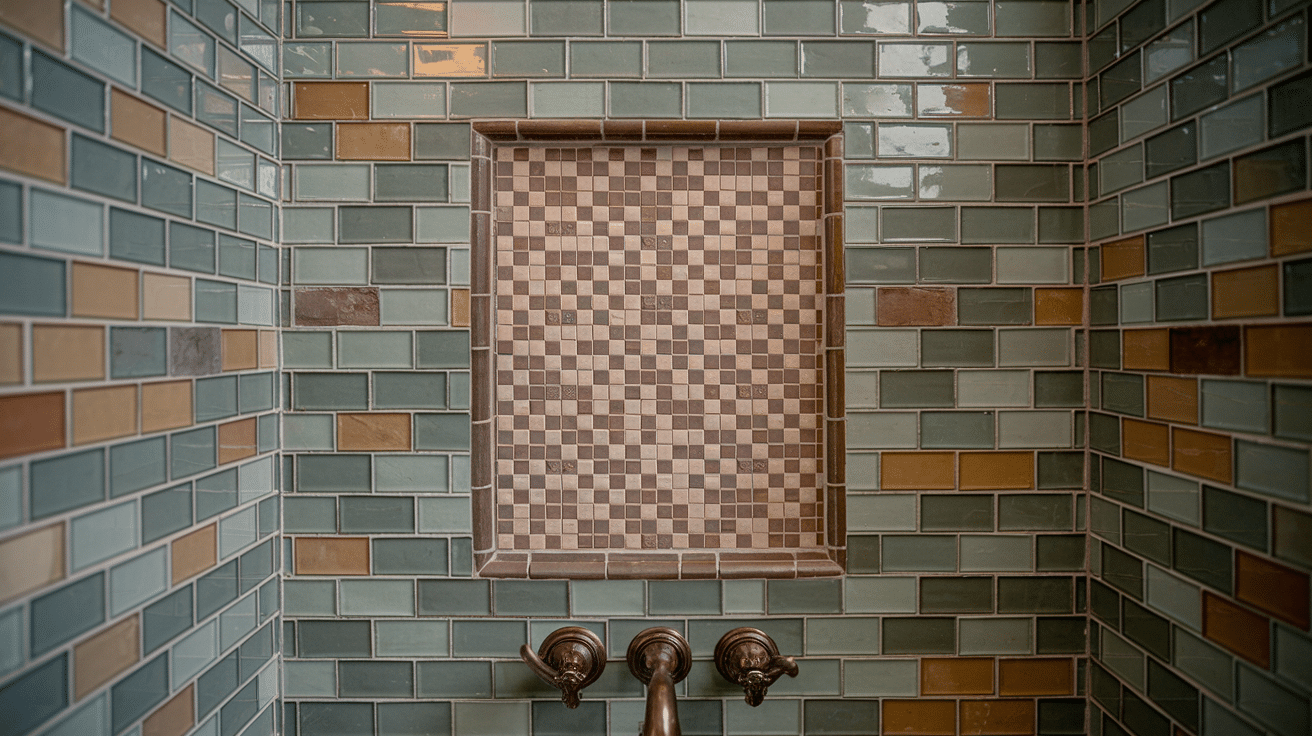
Tile selection in a Craftsman bathroom is an art form that celebrates texture, depth, and artisanal craftsmanship.
Subway tiles, classic mosaics, and artisan-style ceramic tiles create a rich, textured backdrop that reflects the movement’s commitment to handmade quality.
The tiles often feature earthy glazes in muted tones, such as soft greens, warm browns, and subtle terra-cotta, which create depth and visual interest.
Handmade or hand-glazed tiles are particularly prized, with slight variations that tell the story of their creation.
Whether used as a full wall covering, a decorative border, or a carefully placed accent, these tiles bring an authentic, handcrafted feel that is quintessentially Craftsman.
3. Signature Craftsman Colors
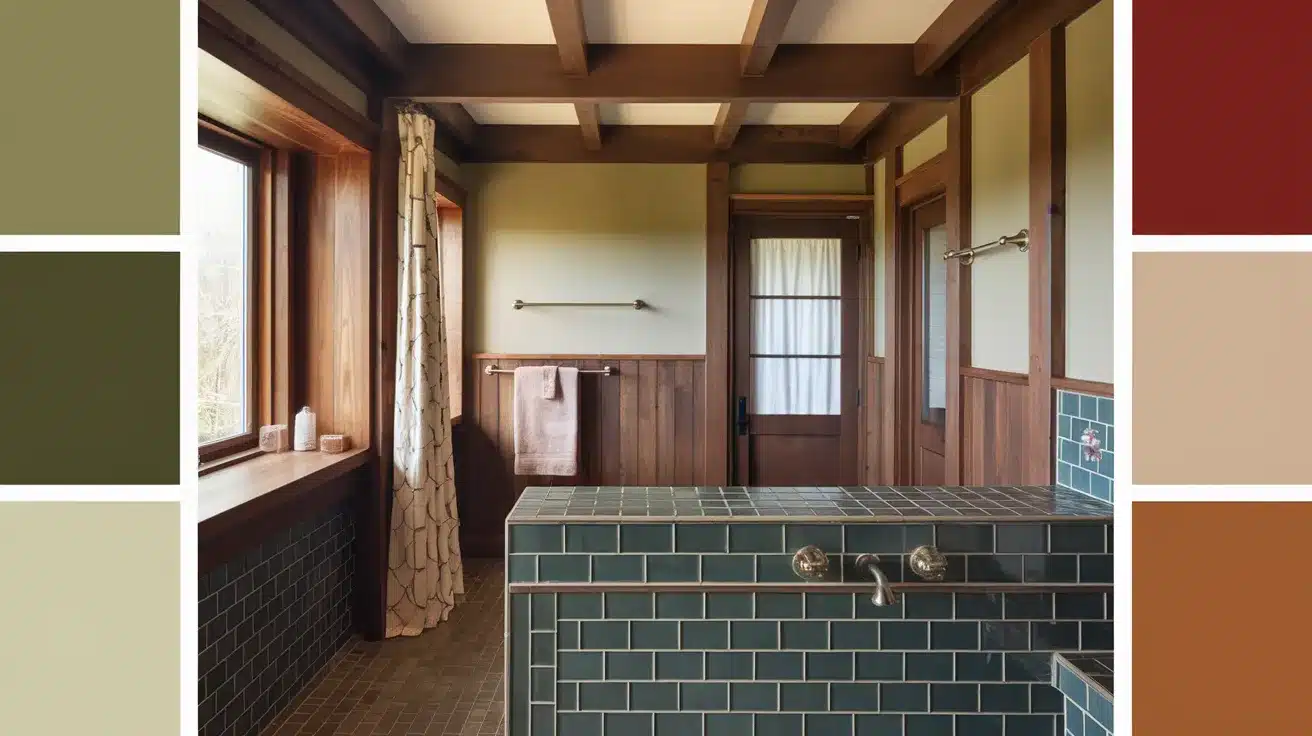
The color palette of a Craftsman bathroom draws directly from nature, creating a warm and inviting atmosphere that connects the space to its natural roots.
Olive green represents the depth of forest landscapes, while deep brown echoes the richness of natural wood. Soft beige provides a neutral backdrop, and rusty red adds warmth and character.
When selecting colors, the key is to create a harmonious blend that feels both earthy and sophisticated.
Consider pairing a deep green tile with cream-colored walls, or use a rusty red as an accent against warm brown woodwork.
The goal is to create a cohesive color story that feels organic, balanced, and true to the Craftsman’s style.
4. Vintage-Inspired Fixtures
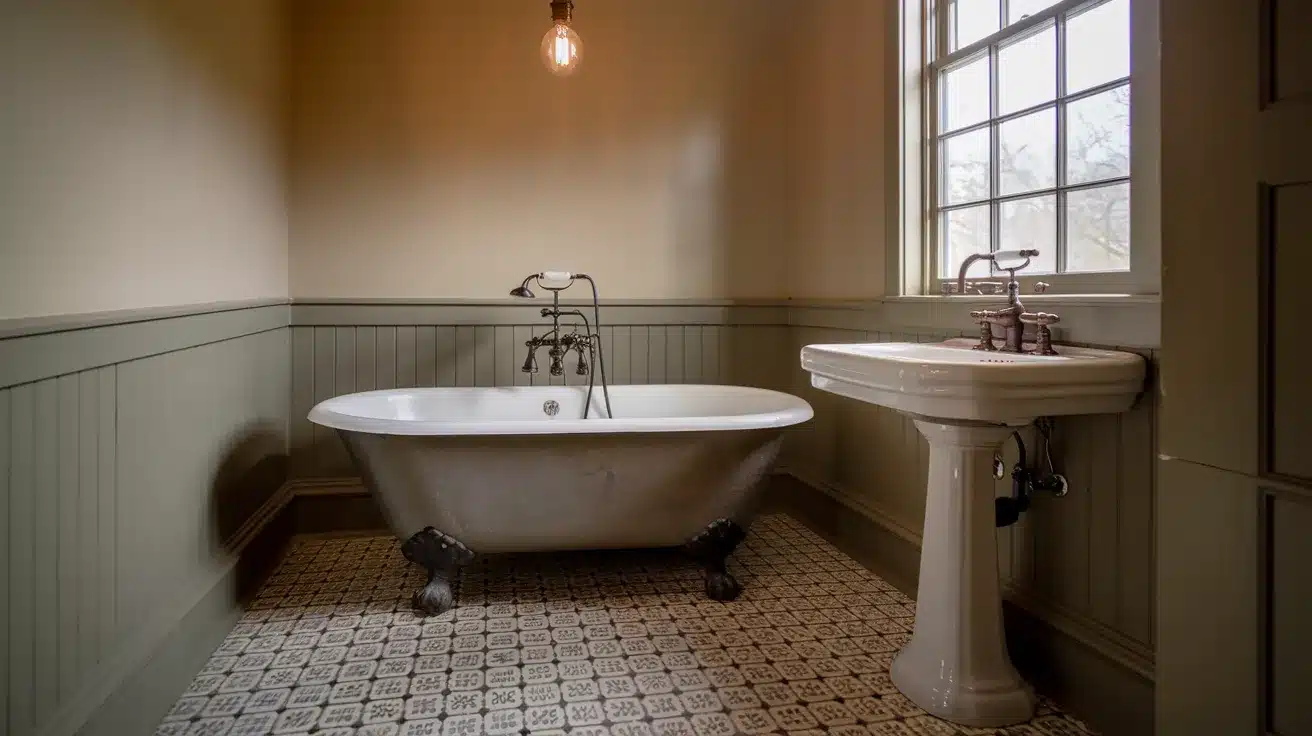
Fixtures in a Craftsman bathroom are more than functional elements—they are carefully chosen pieces that contribute to the overall design narrative.
Reproduction faucets in bronze or copper finishes capture the era’s authentic style, while pedestal sinks and classic claw-foot tubs evoke a sense of historical craftsmanship.
Lighting plays a crucial role, with exposed bulb fixtures or bronze-finished sconces that provide both illumination and decorative impact.
These fixtures are selected not just for their look but for their ability to tell a story of quality, simplicity, and attention to detail.
Each piece is chosen to complement the room’s overall design, creating a cohesive and thoughtful space.
5. Storage That’s Built to Last
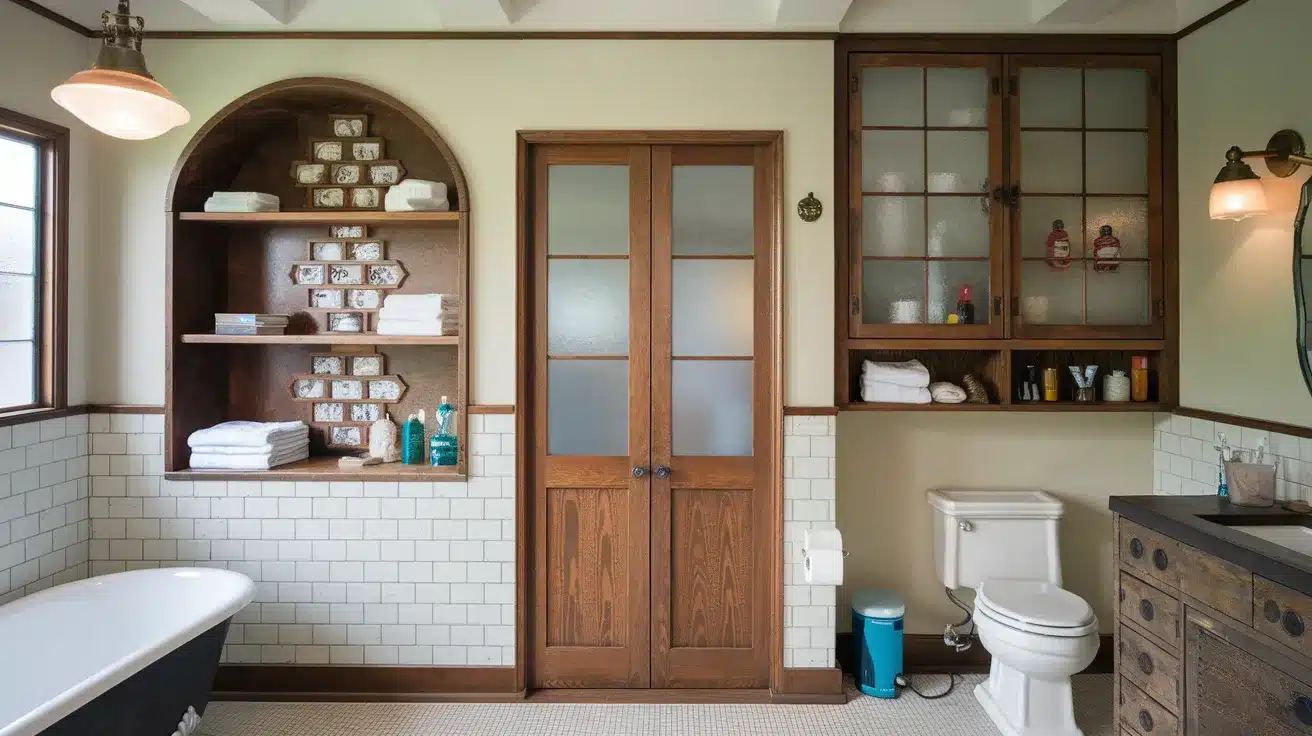
Storage in a Craftsman bathroom is a testament to the design philosophy of form meeting function.
Recessed shelving seamlessly integrates into the walls, providing practical storage without disrupting the room’s clean lines.
Cabinets with glass panels showcase the beauty of carefully crafted woodwork while offering practical storage solutions.
Wood-panel linen closets and custom towel nooks are designed with the same attention to detail as the room’s primary fixtures, featuring solid wood construction and thoughtful design.
These storage solutions are not mere afterthoughts but integral parts of the bathroom’s design, demonstrating the Craftsman look’s commitment to creating spaces that are both beautiful and supremely functional.
Modern Takes on the Craftsman Look
Modern Craftsman bathroom design combines traditional style with modern touches, keeping the focus on craftsmanship and natural beauty.
This style keeps the heart of Craftsman design but adds sleek, contemporary elements that work well today.
- Floating Vanities: Floating vanities made from rich wood give a modern update to traditional cabinetry. These vanities maintain the Craftsman feel with their natural materials but create a more open and airy look.
- Frameless Showers with Wood Trim: Frameless glass showers with wood trim offer a clean, modern design that still honors the Craftsman style. They keep things simple while using natural materials, which is key to the look.
- Sleek Fixtures: Modern fixtures in finishes like bronze, copper, or matte black add functionality while matching the Craftsman aesthetic. These fixtures focus on clean, geometric lines, staying true to the Craftsman design.
- Sustainable Materials: More Craftsman bathrooms today are using sustainable materials. Eco-friendly tiles, reclaimed wood, and energy-efficient lighting help modernize the design while keeping the original craftsmanship.
- Innovative Lighting: New lighting options, like LED strip lights and pendant lights with a vintage feel, add both light and style to the room. These modern lighting choices complement the Craftsman design’s simple, practical look.
Small Craftsman Bathroom Design
Designing a small Craftsman bathroom requires creativity, strategic planning, and a deep understanding of both functional needs and design principles.
The core challenge lies in preserving the authentic Craftsman aesthetic while making the most of limited square footage.
Success depends on careful material selection, intelligent layout choices, and a commitment to thoughtful design.
1. Strategic Layout: Maximize Every Inch
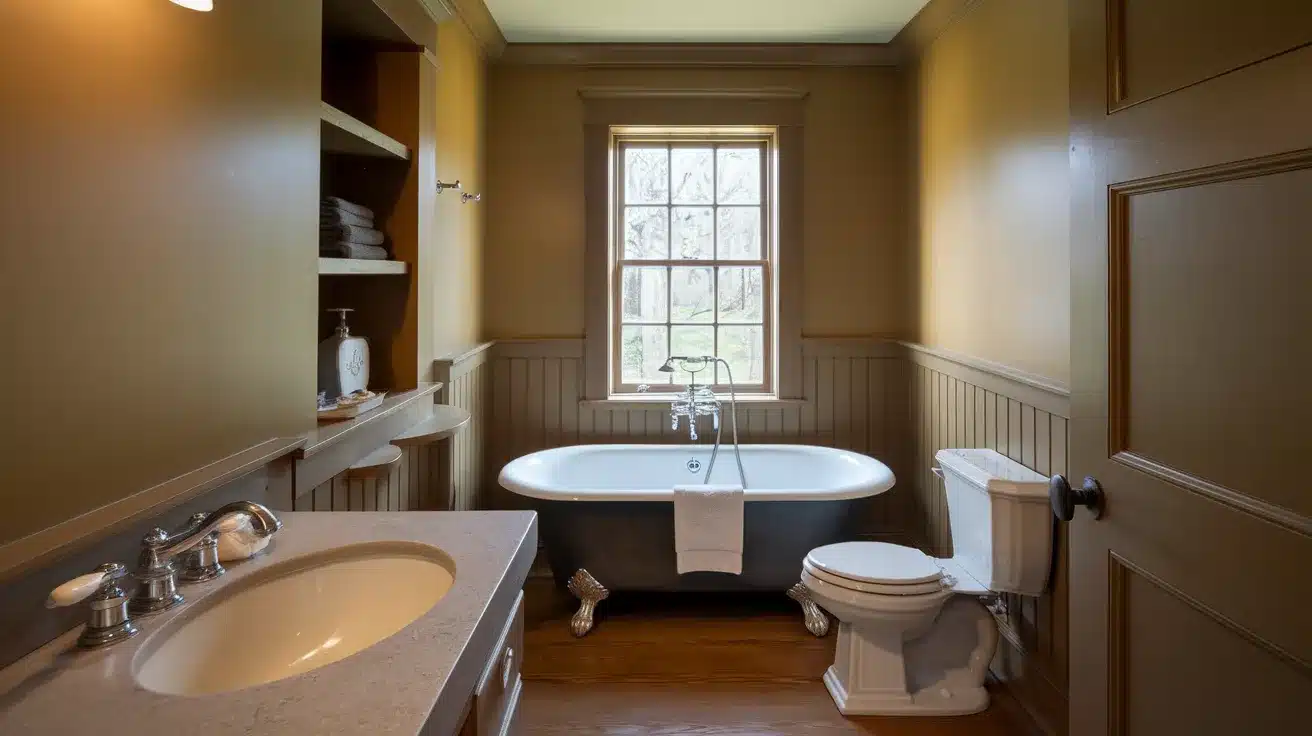
Linear arrangements work best in narrow spaces, with a careful approach to fixture placement that maximizes movement and functionality.
Pocket doors emerge as a game-changing solution, eliminating the swing space required by traditional hinged doors.
These sliding doors not only save precious inches but also perfectly complement the clean, minimalist lines of Craftsman’s design philosophy.
2. Vanity Selection: Form Meets Function
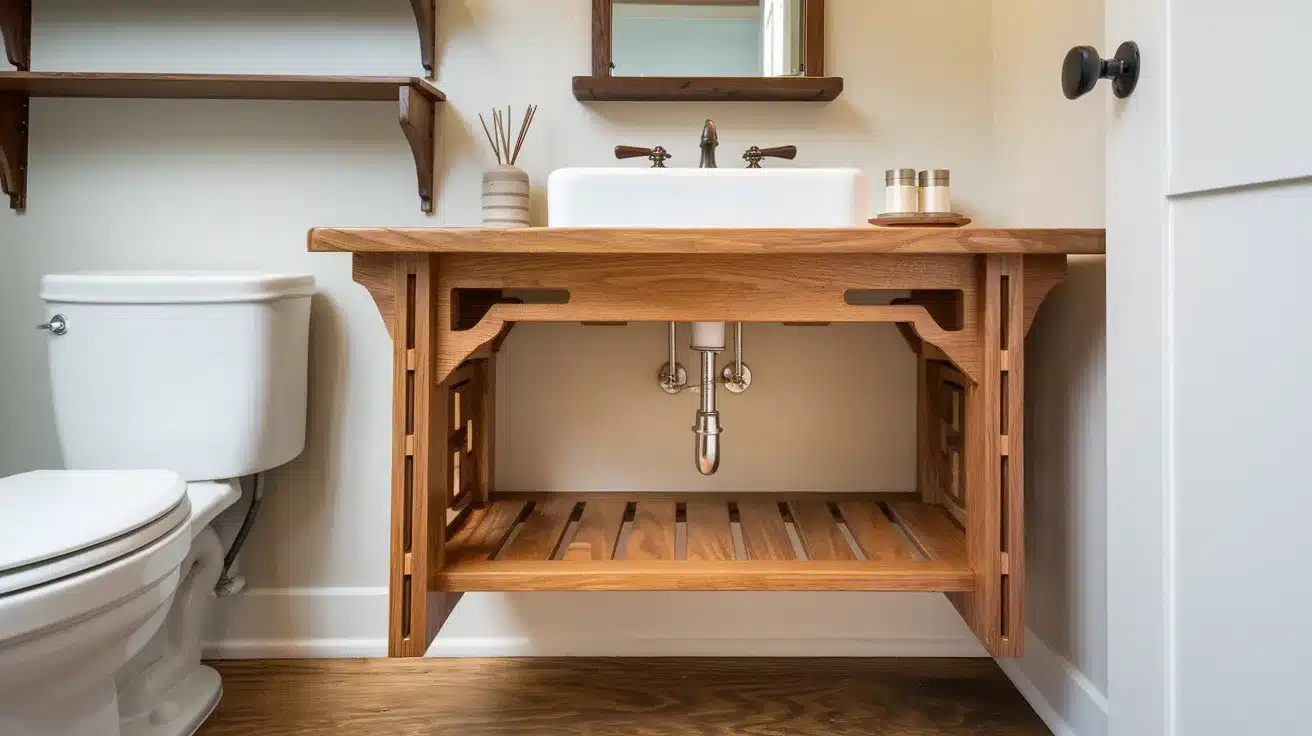
Vanity selection demands particular attention in small bathrooms. Wall-mounted vanities create an illusion of additional floor space, making the room feel more open and airy.
Choose shallow-depth models with integrated storage, focusing on quarter-sawn oak or simple mission-style designs that speak to traditional craftsmanship.
Consider floating vanities with open shelving beneath, which provide storage while maintaining a sense of visual lightness.
3. Lighting and Mirrors
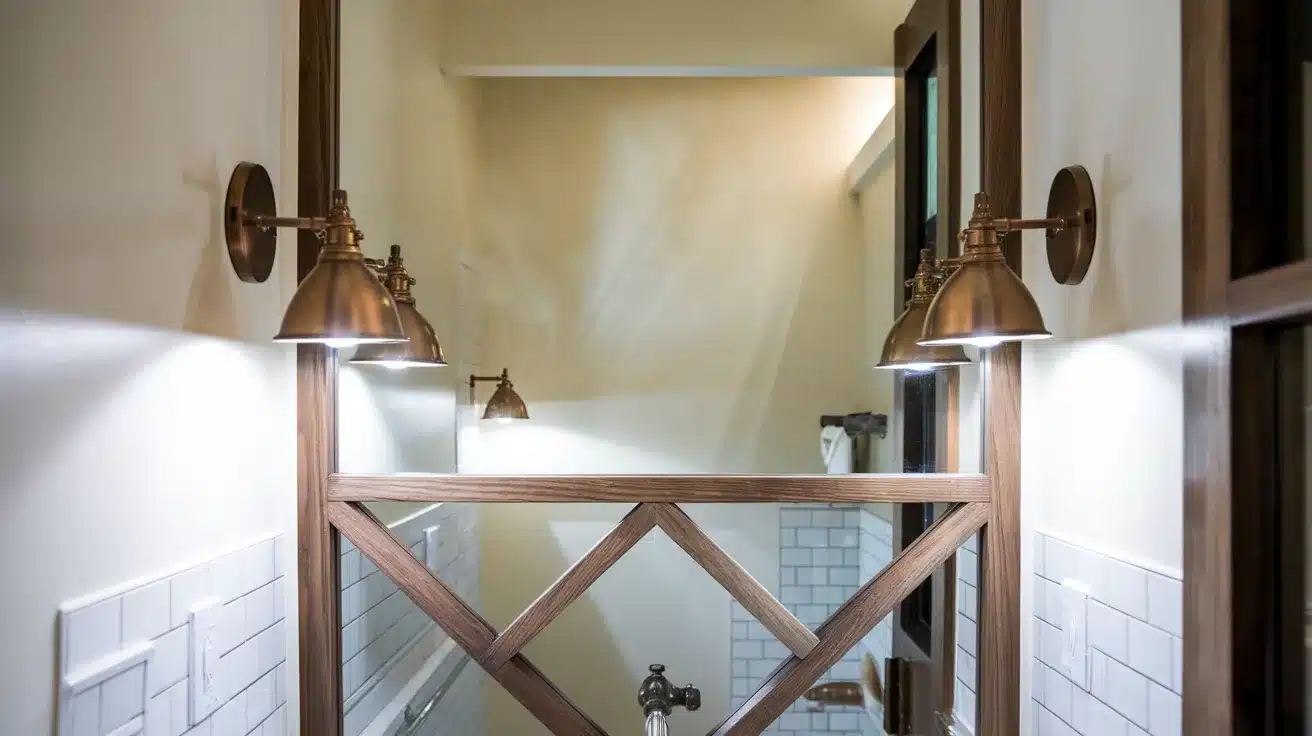
Lighting plays a crucial role in expanding the perceived size of a small bathroom. Strategic mirror placement can dramatically affect the space, reflecting light and creating depth.
Choose mirrors with simple, geometric frames that complement the Craftsman style. Sconce lighting on either side of the mirror provides balanced illumination while adding decorative elements true to the design style.
4. Color and Tile Strategies
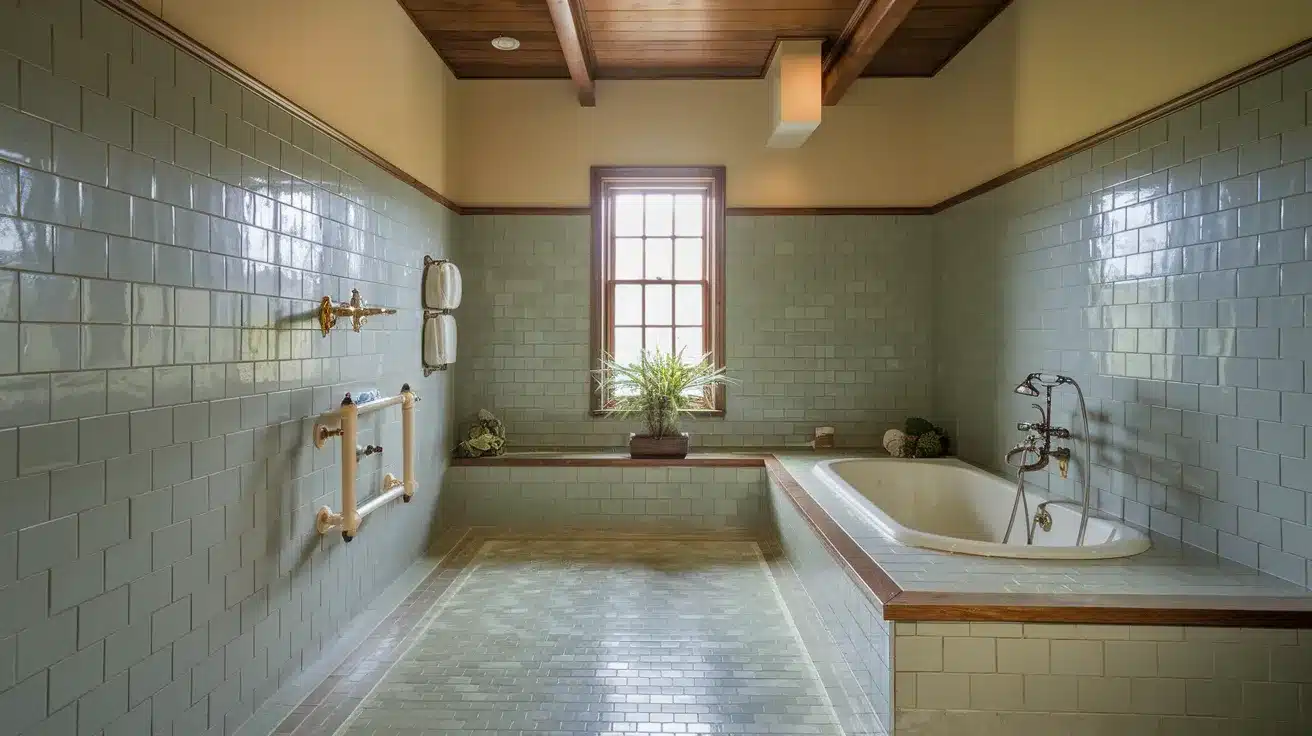
Color and material choices can make a small bathroom feel more open. Light-colored tiles in soft, natural tones like cream, light sage, or pale terra cotta can help the space appear larger.
Large-format tiles with minimal grout lines reduce visual breaks, which adds to the feeling of openness.
You can start with a neutral base and then add green or brown tiles as accents to stay true to the Craftsman color palette.
5. Smart Storage Solutions
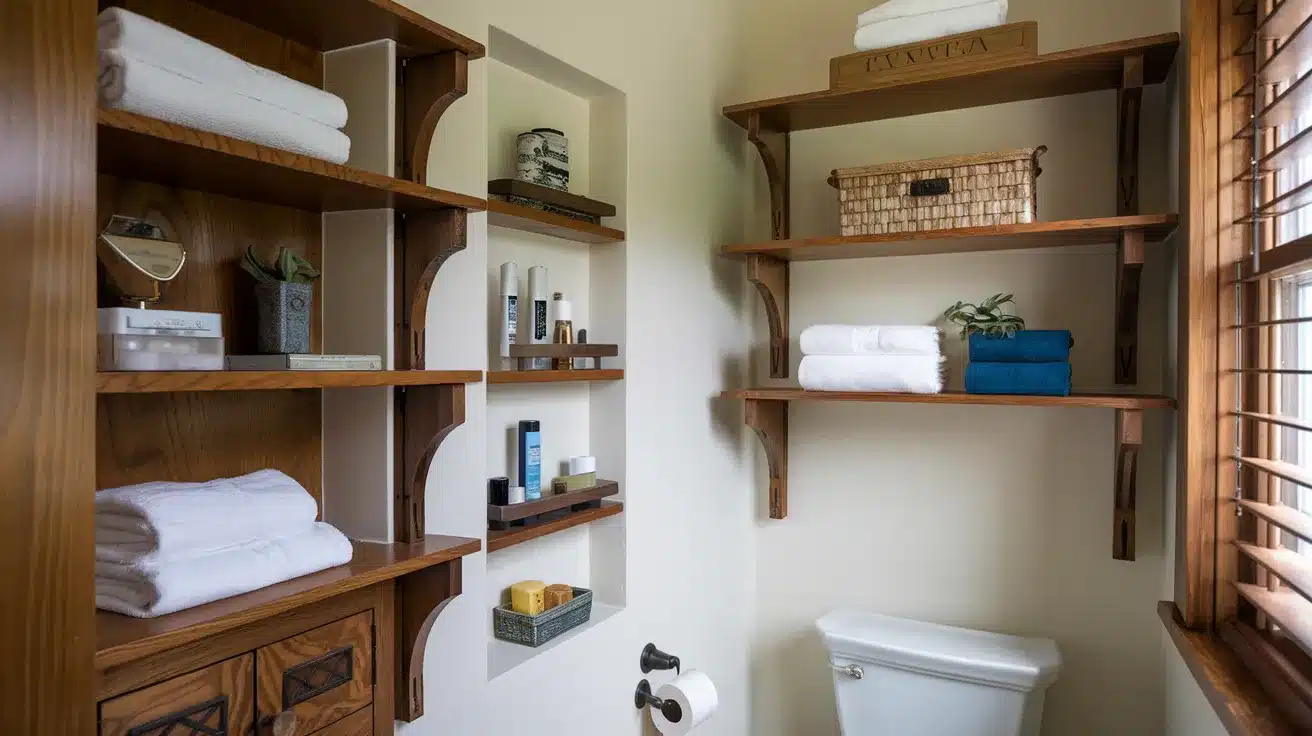
Storage solutions require creative thinking in compact spaces. Built-in shelving recessed between wall studs provides storage without consuming floor space.
Medicine cabinets with mission-style frames offer both functionality and design continuity.
Consider vertical storage options, such as tall, narrow shelving units or over-toilet storage, which maximizes vertical space without cluttering the room.
6. Use of Natural Light
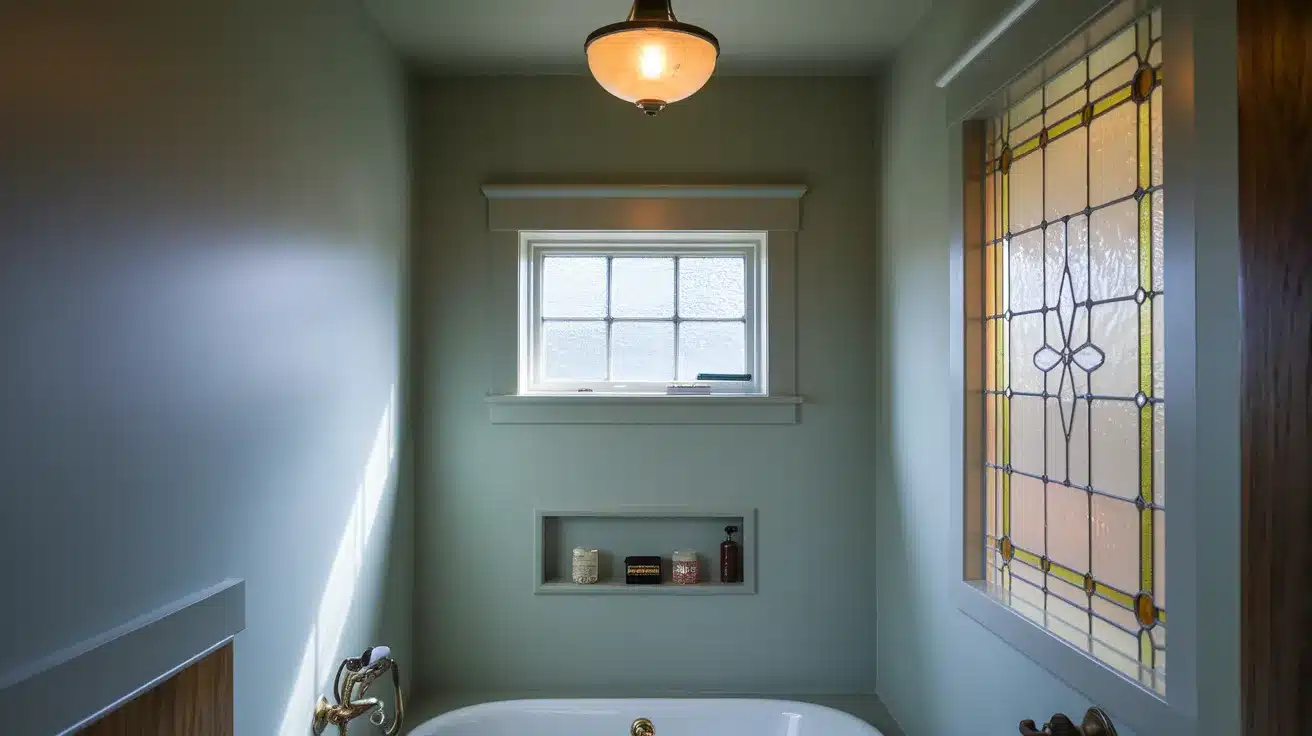
Natural light becomes a critical element in small bathroom design. If possible, incorporate a small window or skylight to bring in natural illumination and adding frosted glass maintains privacy while allowing light to penetrate.
Window treatments should be minimal, perhaps with a simple stained-glass panel that adds a traditional Craftsman touch while filtering light beautifully.
7. Choosing a Color Palette

The color palette should remain true to Craftsman principles: earthy, subdued tones that create a sense of calm and connection to nature.
Sage greens, warm browns, soft blues, and muted terra cotta work beautifully in small spaces. These colors create depth and interest without overwhelming the limited square footage.
Conclusion
Craftsman bathrooms offer more than function. They provide a space that tells a story of craftsmanship and care.
Start with small updates or take on a full renovation; each design choice will connect you to a tradition of quality and beauty. From a mission-style mirror to a complete room, every detail reflects your home’s unique style.
Use natural materials, focus on simplicity, and create a space that feels truly yours. A Craftsman bathroom can be a lasting testament to classic design, warmth, and personal expression.
For more ideas and inspiration, read our other blogs to see how you can bring more style into your home.

